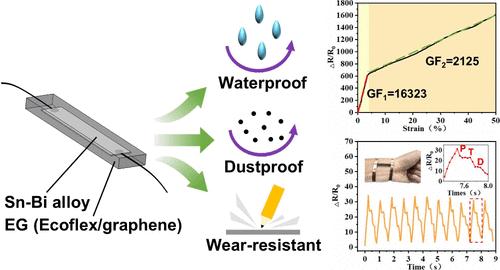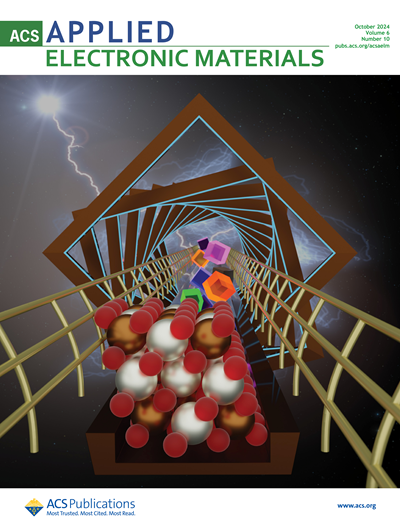基于 EG/Sn-Bi/EG 封装夹层结构的高灵敏、可修复、灵活且传感范围广的应变传感器
IF 4.7
3区 材料科学
Q1 ENGINEERING, ELECTRICAL & ELECTRONIC
引用次数: 0
摘要
使用锡铋合金薄膜作为敏感层,制备了一种具有高灵敏度和简单可修复性的封装夹层结构柔性应变传感器。通过结合石墨烯和 Ecoflex 制备了导电复合材料,以完全封装敏感层。由此制成的柔性应变传感器具有感应范围宽(50%)、灵敏度系数高(16323(0 < ε < 3.84% )和 2125(3.84% < ε < 50% )、响应时间快(约 46 毫秒)和耐用性高(在需要修复前可进行 4800 次拉伸释放循环)等特点。高灵敏度归功于拉伸过程中在锡铋合金薄膜上产生的裂纹,EG(Ecoflex/石墨烯)层在大应变下保持了导电通路,大大扩展了传感范围。此外,外表面的 EG 层还为锑铋合金薄膜提供了强有力的保护,赋予了传感器防水、防尘和耐摩擦的特性,而这正是各种日常生活场景所需要的。经过 6000 次拉伸和释放循环后,锑镍合金薄膜上的裂纹积累产生了显著的残余电阻。由于 Sn-Bi 合金薄膜的熔点低至 47 °C,因此采用简单的热压处理就能快速有效地将受损的 Sn-Bi 合金薄膜恢复到初始状态。这项研究为实现应变传感器的高灵敏度和宽传感范围提供了一种有效方法。封装夹层结构设计赋予了传感器修复能力和抗外部环境干扰能力。该传感器在健康监测、电子皮肤和可穿戴设备中的应用潜力巨大。本文章由计算机程序翻译,如有差异,请以英文原文为准。

Highly Sensitive, Repairable, and Flexible Strain Sensors with a Wide Sensing Range Based on an EG/Sn–Bi/EG-Encapsulated Sandwich Structure
An encapsulated sandwich-structured flexible strain sensor with high sensitivity and simple repairability was prepared using a Sn–Bi alloy film as the sensitive layer. Conductive composite materials were prepared by combining graphene with Ecoflex, to completely encapsulate the sensitive layer. The resultant flexible strain sensor demonstrated a wide sensing range (50%), high sensitivity coefficient of 16323 (0 < ε < 3.84%) and 2125 (3.84% < ε < 50%), rapid response time (approximately 46 ms), and high durability (∼4800 stretch-release cycles before needing repair). The high sensitivity was attributed to the cracks generated in the Sn–Bi alloy film during the stretching process, and the EG (Ecoflex/graphene) layer maintained the conductive pathways under large strains, greatly expanding the sensing range. Furthermore, the EG layers on the outside surfaces provided robust protection for the Sn–Bi alloy film, endowing the sensor with water, dust, and friction resistance, which is needed in various daily life scenarios. After 6000 cycles of stretching and releasing, the accumulation of cracks in the Sn–Bi alloy film resulted in significant residual resistance. With the melting point of the Sn–Bi alloy film as low as 47 °C, a simple thermal pressing treatment was used to rapidly and efficiently restore the damaged Sn–Bi alloy film to its initial state. This work presents an effective approach for achieving both high sensitivity and a wide sensing range in strain sensors. The encapsulated sandwich structure design endows the sensor with repair capabilities and resistance to external environmental interference. The sensor demonstrates significant potentiality for applications in health monitoring, electronic skin, and wearable devices.
求助全文
通过发布文献求助,成功后即可免费获取论文全文。
去求助
来源期刊

ACS Applied Electronic Materials
Multiple-
CiteScore
7.20
自引率
4.30%
发文量
567
期刊介绍:
ACS Applied Electronic Materials is an interdisciplinary journal publishing original research covering all aspects of electronic materials. The journal is devoted to reports of new and original experimental and theoretical research of an applied nature that integrate knowledge in the areas of materials science, engineering, optics, physics, and chemistry into important applications of electronic materials. Sample research topics that span the journal's scope are inorganic, organic, ionic and polymeric materials with properties that include conducting, semiconducting, superconducting, insulating, dielectric, magnetic, optoelectronic, piezoelectric, ferroelectric and thermoelectric.
Indexed/Abstracted:
Web of Science SCIE
Scopus
CAS
INSPEC
Portico
 求助内容:
求助内容: 应助结果提醒方式:
应助结果提醒方式:


